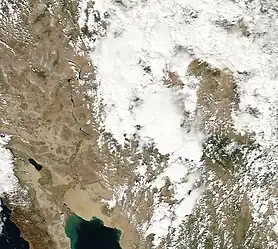
A tornado outbreak is the occurrence of multiple tornadoes spawned by the same synoptic scale weather system.[1] The number of tornadoes required to qualify as an outbreak typically are at least six to ten, with at least two rotational locations (if squall line) or at least two supercells producing multiple tornadoes.[2][3]
The tornadoes usually occur within the same day or continue into the early morning hours of the succeeding day, and within the same region. Most definitions allow for a break in tornado activity (time elapsed from the end of the last tornado to the beginning of the next tornado) of six hours. If tornado activity indeed resumes after such a lull, many definitions consider the event to be a new outbreak. A series of continuous or nearly continuous tornado outbreak days is a tornado outbreak sequence.[4] In the United States and Canada, tornado outbreaks usually occur from March through June in the Great Plains, the Midwestern United States, and the Southeastern United States in an area colloquially referred to as Tornado Alley. Tornado outbreaks can also occur during other times of the year and in other parts of the world. A secondary less active and annually inconsistent tornado "season" in the U.S. occurs in late autumn.[5]
Very large tornado outbreaks are known as super outbreaks. The largest tornado outbreak on record was the 2011 Super Outbreak, with 362 tornadoes and about $10 billion in direct damages.[6] It surpassed the 1974 Super Outbreak, in which 148 tornadoes were counted. Both occurred within the United States and Canada. The total number of tornadoes is a problematic method of comparing outbreaks from different periods, however, as many more weaker tornadoes, but not stronger tornadoes, are reported in the US in recent decades than in previous ones due to improvements in tornado detection.[7]
See also
References
- ↑ Glickman, Todd S., ed. (2000). Glossary of Meteorology (2nd ed.). American Meteorological Society. ISBN 978-1-878220-34-9. Archived from the original on 6 June 2011.
- ↑ Grazulis, Thomas P. (1993). Significant Tornadoes 1680-1991: A Chronology and Analysis of Events. St. Johnsbury, VT: The Tornado Project of Environmental Films. ISBN 978-1-879362-03-1.
- ↑ Galway, Joseph G. (1977). "Some Climatological Aspects of Tornado Outbreaks". Mon. Weather Rev. 105 (4): 477–84. Bibcode:1977MWRv..105..477G. doi:10.1175/1520-0493(1977)105<0477:SCAOTO>2.0.CO;2.
- ↑ Schneider, Russell; H. E. Brooks; J. T. Schaefer (2004). "Tornado Outbreak Day Sequences: historic events and climatology (1875-2003)". 22nd Conference on Severe Local Storms. Hyannis, MA: American Meteorological Society.
- ↑ Schneider, Russell; H. E. Brooks; J. T. Schaefer (2004). "Tornado Outbreak Days: an updated and expanded climatology (1875-2003)". 22nd Conference on Severe Local Storms. Hyannis, MA: American Meteorological Society.
- ↑ Smith, Adam B.; Matthews, Jessica L. (July 2015). "Quantifying uncertainty and variable sensitivity within the US billion-dollar weather and climate disaster cost estimates". Natural Hazards. 77 (3): 1829–1851. doi:10.1007/s11069-015-1678-x. ISSN 0921-030X. S2CID 129795283.
- ↑ Doswell, Charles A. III (2007). "Small Sample Size and Data Quality Issues Illustrated Using Tornado Occurrence Data". Electron. J. Sev. Storms Meteorol. 2 (5): 1–16.
Further reading
- Corfidi, Stephen (2013). "Noteworthy North American Tornado Outbreaks". NOAA-NWS-NCEP Storm Prediction Center (poster).
- Doswell, Charles A. III; R. Edwards; R.L. Thompson; J.A. Hart; K.C. Crosbie (2006). "A Simple and Flexible Method for Ranking Severe Weather Events". Weather Forecast. 21 (6): 939–51. Bibcode:2006WtFor..21..939D. CiteSeerX 10.1.1.529.5483. doi:10.1175/WAF959.1.
- Edwards, Roger; R. L. Thompson; C. Crosbie; J. A. Hart; C. A. Doswell (2004). "Proposals for modernizing definitions of tornado and severe thunderstorm outbreaks". 22nd Conference on Severe Local Storms. Hyannis, MA: American Meteorological Society.
- Forbes, Gregory S. (2006). "Meteorological aspects of high-impact tornado outbreaks". Symposium on the Challenges of Severe Convective Storms. Atlanta, GA: American Meteorological Society.
- Mercer, Andrew E.; C.M. Shafer; C.A. Doswell III; L.M. Leslie; M.B. Richman (December 2009). "Objective Classification of Tornadic and Nontornadic Severe Weather Outbreaks". Mon. Wea. Rev. 137 (12): 4355–68. Bibcode:2009MWRv..137.4355M. CiteSeerX 10.1.1.736.9711. doi:10.1175/2009MWR2897.1. S2CID 15831045.
- Moller, Alan R. (1979). "The Climatology and Synoptic Meteorology of Southern Plains' Tornado Outbreaks". M.S. Thesis. Norman, OK: University of Oklahoma.
- Shafer, Chad; C. Doswell (2011). "Using kernel density estimation to identify, rank, and classify severe weather outbreak events". Electron. J. Sev. Storms Meteorol. 6 (2).
- Shafer, Chad; C. Doswell; L. Leslie; M. Richman (2010). "On the use of areal coverage of parameters favorable for severe weather to discriminate major outbreaks". Electron. J. Sev. Storms Meteorol. 5 (7).
- Shafer, Chad; C.A. Doswell (2010). "A Multivariate Index for Ranking and Classifying Severe Weather Outbreaks". Electron. J. Sev. Storms Meteorol. 5 (1).
- Thompson, Richard L.; M.D. Vescio (1998). "The Destruction Potential Index – a method for comparing tornado days (DPI)". 19th Conference on Severe Local Storms. Minneapolis, MN: American Meteorological Society.
- Verbout, Stephanie M.; H.E. Brooks; L.M. Leslie; D.M. Schultz (2006). "Evolution of the U.S. Tornado Database: 1954-2003". Weather Forecast. 21 (1): 86–93. Bibcode:2006WtFor..21...86V. doi:10.1175/WAF910.1.